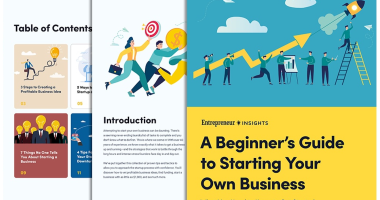
Let’s face it, every new and successful enterprise is the result of someone with an idea. People aren’t going to finance you without knowing your idea. Sometimes the idea is so powerful that it generates a tremendous response right off the bat. This is unusual, but it does happen—it’s when the reader stops you and says, “You don’t have to tell me any more; I’m sold.” More often, you’ll need to explain why your idea has merit and how it can solve a common problem by making things easier, faster, or cheaper for the prospective customer(s).
Business ideas that no one has ever thought of are rare. So are new inventions. But new spins on old ideas are plentiful. Some of these are game changers, while others simply give consumers something new that solves a problem or makes some aspect of life easier. Then there are ideas that fall into the “same old, same old” category. No matter how brilliantly crafted, written, and presented your business plan is, it will be difficult to win your investors, and later customers, with an old idea that does not have a new twist. Therefore, you want to wow them first with your idea! If they’re not interested, no matter what your financials are, they won’t help.
How Much Cash Do You Need?
If you are using your plan as a financing proposal, and you probably are, put this information right up front. Are you seeking a loan, convertible debt, or equity investment? What terms, both in interest and length of loan, are you requesting? If equity, what is the probable exit strategy—and when will the exit strategy be executed?
Some readers will stop right here. That’s fine. Other readers will appreciate your frankness. Being coy about amounts and terms will only harm your venture.
How Will You Use the Cash?
Provide a short explanation of how you’ll use any financing you seek. Tell the investor why you need the money. Nobody wants to lend you money if they don’t know exactly why you need it. It’s not necessary to get into much detail here—just make it clear that you need it for x, y, and z. You don’t have to justify every penny and wind up feeling obligated to ask for a loan of $23,558.36 because that’s the exact price of everything you need. You should also let the reader know how the investment will help the company grow and/or increase its profits. Why else would you be seeking funding? The best use of somebody else’s money is to buy or build something that will make more money, both for you and for that person.
Understand the Goals of Financiers
In your executive summary, consider the following:
- Friends and family want to get their money back someday but are not very interested in timing and returns.
- Bankers look for free cash flow to pay back the principal and interest of their loans. They also look closely at management experience and marketing. They may ask for collateral. By law they have to be conservative, that is, risk-averse, so they are not great candidates for risky financing.
- Angel investors look for moderate rates of return, usually above the prime rate, plus some capital appreciation. They sometimes want to be involved at a hands-on level.
- Venture capitalists seek annual compound rates of return in the area of 35 to 50 percent per annum. They seldom want to go longer than three to five years to cash out. They always want to know what the exit strategy is.
You may have special considerations to address in any given plan, depending on its target. For instance, you may know or suspect that one of the conditions of getting a loan from your parents is that you employ your black-sheep cousin. Be sure your summary of management has a slot—Director of Ephemera might work—for that unworthy individual.
Don’t forget yourself: It’s a rare company that doesn’t have any investment from the entrepreneur or entrepreneurs who started it.
Who Will Own What?
When a business starts generating profits and plowing them back into the firm, value can build rapidly. Even if you aren’t in an industry likely to purchase buildings or patent valuable technology, the business derives value from the fact that it can generate profits into the future.
Because your business is valuable, spell out who owns what. If you have many equity investors coupled with a pile of creditors, this can get pretty complicated.
For the summary section of your plan, a basic description such as “Ownership of the company will be divided so that each of the four original partners owns 25 percent” will suffice. If you have to negotiate details of exactly what any equity investors will get, there’s time to do that later. For now, you just want to give people an idea of how the ownership will be divided.
It’s Not All About Money
No matter if you’re sharing your plan with an investor, customer, or team member, your plan needs to show that you’re passionate, dedicated, and that you actually care about your business and the plan. You can also discuss the mistakes that you’ve learned from, list the problems that you’re hoping to solve, describe your values, and establish what makes you stand out from the competition.
By explaining why you care about your business, you create an emotional connection with your readers so that they’ll support you, your team, and your organization.
Bonus Business Plan Pointers
- Assessing your own strengths and weaknesses is a lot harder than assessing others’ good and bad points, right? So when it comes time to select your best features, it’s also time to solicit feedback from others. Ask people whose opinions you trust, such as colleagues, associates, and peers, whether your assessment of your idea is off-base or on target.
- “The executive summary provides quick access to critical information from your more detailed business plan. It is essential for informing anyone outside of your business. Many people—including investors and bankers—will only read your summary. Others will use it to decide if they should read the rest. For you, it is a snapshot of your business to reference when planning or revising your strategy. Now if you’re writing a business plan solely for internal use you may not need an executive summary. However, some internal plans—such as an annual operations plan or a strategic plan—benefit from having a summary. It takes some effort to do a good summary, so if you don’t have a business use in mind, don’t do it.” — from “How to Write an Executive Summary” by Tim Berry








